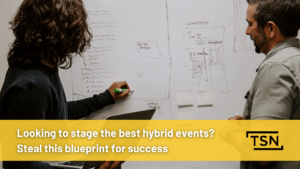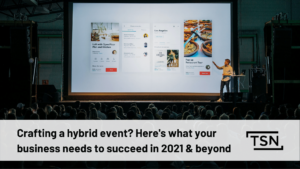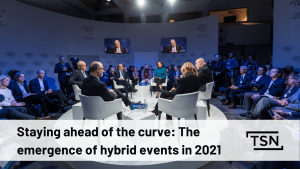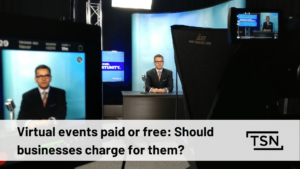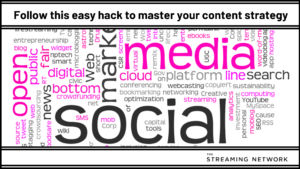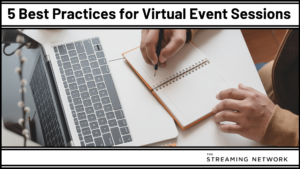Podcast: Play in new window | Download | Embed
Subscribe: Apple Podcasts | Google Podcasts | RSS
- Is there even any value in not-for-profit webinars? We’ll tackle the key benefits of not-for-profit webinars, including new audience reach opportunities.
- How did an organization put live and virtual strategies to use? We’ll break down real-life success stories about multi-regional engagement from TESL.
- How have not-for-profit webinars enhanced membership and funding? We discuss the value in anonymous audience engagement that is unique to many not-for-profits such as Autism Ontario.
- Tips for hosting not-for-profit webinars. We’re giving you some of our best tips to those NFPs looking to move into webinars and live virtual events.
The Complete Transcript On
Not-For-Profit Webinars
Peter Vamos: Welcome to LFTF, the podcast about turning your webinar into a lead generation machine and advancing your business objectives. With me as usual, Matthew Ley, president of The Streaming Network.
Matthew Ley: Thanks for having me, Pete. And you–I believe that is what you said last time for the title.
Peter Vamos: I think I nailed it. That’s it.
Matthew Ley: So, I think maybe we’ve gotten the same–.
Peter Vamos: –We got it–.
Matthew Ley: –Title twice in a row–.
Peter Vamos: –We got it, so–.
Matthew Ley: –But we’re not talking about lead generation today.
Peter Vamos: No. Well, a little bit.
Matthew Ley: Okay.
Peter Vamos: It’s a–I think–and we’ll get into it. But one of the–so, what we want to talk about is not-for-profits. And I was reading an article talking about how not-for-profits use advanced webinar, virtual events platforms.
Matthew Ley: Yep.
Peter Vamos: And we spend a lot of time talking about, you know, how business–businesses can use–.
Matthew Ley: –Yeah–.
Peter Vamos: –Our platform as a lead generation tool. But there’s–you know, I was surprised to learn that these NFPs are using them for, like, communication strategies.
Matthew Ley: Yeah.
Peter Vamos: And so, what’s driving that? Like, what are we seeing right now when we–and we deal with some of these–.
Matthew Ley: –Yeah–.
Peter Vamos: –Types of companies, right?
Matthew Ley: Yeah, we do. And, I mean, I don’t think it’s any surprise. I think that, you know, this podcast will be listened to by people who aren’t used to our program, I think–.
Peter Vamos: –Um-hmm–.
Matthew Ley: –Because it’ll be not-for-profits that’ll be showing up. But–and I’m not saying anything that they don’t know, that 51% of associations out there are facing a decline in membership. And the reason that the audiences are not, you know, re-signing up or not seeing value is they feel that there is a lack of engagement with the associations.
So, they’re struggling to find a technology mechanism to reach everyone. Webinar has been part of the kit for a long time. But really, these associations used to rely on–in-person chapter events was the big thing, getting everyone in a room, whether it was the Chamber of Commerce or any other not-for-profit that we all know well.
And it’s a–they’re facing the same struggles that all of our marketers and everyone else is facing, and that is it’s a changing world. It’s a–changing demographics of people that they’re trying to reach. And there is a battle for time that is greater than it’s ever been with everything available to us at our fingertips. And so, they have a declining number of bums in seats.
Combine that with declining membership and they need to find ways of using technology like webinars that, again, have been part of their kit for a while, to better engage their audience so–or their members. So, a lot of them are really taking to the technology.
Peter Vamos: Right. And a lot of them are using–you know, financial services businesses use these types of platforms for–to educate–.
Matthew Ley: –Yeah–.
Peter Vamos: –To bring advisors in–.
Matthew Ley: –Continuing education–.
Peter Vamos: –And continued education. But this is also something that not-for-profits employ in–.
Matthew Ley: –Yeah–.
Peter Vamos: –A very similar sort of way.
Matthew Ley: Exactly. I mean, a lot of associations, not–for–profits, NGOs, one of the values that they provide to their audience is targeted learning. And in some cases, it’s just broad-based education. In other cases, it’s actual accreditation. A lot of association professionals, those agents anyways, deliver a lot of accreditation to their audience.
And so, the webinar is a way for them to reach–whether it be you’re in Ontario or a state association or you’re a national, it allows you to reach everyone that–possible with that educational content. And then the other thing that it does, when done right and well, is every webinar on our platform almost are archived and available on-demand.
And we are in an on-demand world. Every dataset in the benchmarks report, every customer that we go through on our quarterly or annual reviews are seeing their on-demand viewership rise. People are viewing them longer and they’re consuming more on-demand content.
And committing to an education-based webinar program, sure, it reaches people–more people than live, but it also now has a value for your members who you’re trying to sign up, new members, is that you’ve got this catalog of 10, 20, hundreds of educational content where they can get all their credits that they needed or some, or they can just learn the things that they need to learn from industry experts.
Peter Vamos: Right. A lot of them as well will–they’ll create events. They’ll do the stuff on the ground–.
Matthew Ley: –Yeah–.
Peter Vamos: –Where they bring members in.
Matthew Ley: Yeah.
Peter Vamos: They bring in experts and provide them with insight. But this really–expanding the reach of this thing–.
Matthew Ley: –Yeah–.
Peter Vamos: –Expanding the reach of their events really becomes part of the driver as well, right?
Matthew Ley: Yeah. And so, when, you know, like anybody, your ticket sales are down is usually when people start thinking about going and broadcasting their event.
But you’re right. A lot of annual conferences will have an educational component to it. They’ll bring in people that they may not have in their webinar program, the big guns. Their budget’s for the annual conference. They want to make it as big as possible. And in many cases, it’s–the highlight of being a member of a certain organization is going to that annual conference, rubbing shoulders with your peers that you don’t normally see, and reaching some of these thought leaders, experts, or whatever it might be.
And so, what–this is actually a place where we usually get introduced as a webcast, premium sort of virtual event provider to our not-for-profit customers, is they’re coming and looking at how do they expand the reach of that physical conference. They might already do webinars on, like, a meeting tool or something, but this is where they first come and talk to us.
And I got a story, an old one, TESL, which is the English–teachers who do English as a second language–.
Peter Vamos: –Um-hmm–.
Matthew Ley: –It’s their association.
Peter Vamos: T-E-S-L.
Matthew Ley: T-E-S-L? Is that what it is? Okay.
Peter Vamos: I don’t know.
Matthew Ley: I call them TESL. I don’t know.
So, TESL, unique situation where they had this big annual conference with lots of learning opportunities. In fact, if you went to the annual conference, you could get your entire sort of recertification done in–if you went to all the sessions, in that three days.
But at the time, and I don’t know if it’s changed because this is–you know, I wouldn’t say a decade ago, but probably seven or eight years ago, TESL or English second–ESL teachers didn’t earn that much. Getting everyone from the outskirts into Toronto was a struggle, so they would apply for grants from I guess the government or their–or the regional school board to pay for them to come in. So, they had a lot of funded people coming in. It was a very large conference. But they had thousands of these teachers who weren’t being reached, and they needed to have this content if they were going to achieve their accreditation.
So, what we did is we just recorded all the sessions in all these different rooms. Put a camera in each room, recorded all the sessions, and then we put them online so that there was 50 hours available every year. And those new 50 hours, teachers would go to this thing for free, go in and they’d watch their 50 hours in the course of the time that they needed, and that ensured that they didn’t need to spend a cent and they were able to get their hours in for continuing education.
So, there’s a lot of great content that happens at conferences. And beyond, you know, expanding out live, hybrid event, which we talk about a lot, just capturing it and then making it available online can be very valuable to your members as well.
Peter Vamos: Right, right.
We do–you know, one of the organizations that we do a lot of work with is Autism Ontario.
Matthew Ley: Yeah.
Peter Vamos: And you’re personally involved in that. You act as the moderator, as the emcee.
Matthew Ley: Um-hmm.
Peter Vamos: I think that’s a good opportunity to put a lot of, you know, meat on the bones in terms of how a platform can be used for an organization like that.
Matthew Ley: Yeah.
Peter Vamos: Let’s talk a little bit about that.
Matthew Ley: So, they’re slightly different in that they have a mandate from the government and funding from the government to basically reach as many people in Ontario with education around autism.
And they do many things. If you don’t know, they’re an amazing organization. And I do this because I think that the work they do is great. And I’ve been personally touched by someone in my family being diagnosed with autism. And so–but they hold training sessions. They hold in-person events.
But it is very Toronto centric, right? That’s where the experts are. Where the resources are, unfortunately, is in Toronto. And so, getting the–these educational resources out, the webinar program was invented many years ago.
Peter Vamos: Um-hmm.
Matthew Ley: And what has happened is that, because the webinars are able to reach Ontario and actually beyond, that they’re so easily accessible by people, is that–and the tracking is so good on it, meaning that we know–people sign in. They give a lot of information on who they are so they can be categorized. We know how long they view the session for, is that they’re able to engage with so many more people this way. It gets their numbers up.
And when the government sees this, they’re like, okay, now this is working. Well, here’s some more money. Bring in more speakers, do more webinars, ’cause this is working and it’s reaching the numbers that we want to reach. We can put our dollars to–sort of to good use.
Peter Vamos: Right.
Matthew Ley: So, it’s been a super successful program. And it’s–you know, they can get as much as 600, 700 people, tons of questions coming in. It’s information that people generally want. It’s done well. But it’s a great exercise in how to do outreach education to sort of the general public through the medium when you are in that government funded sort of situation.
Peter Vamos: Right.
Matthew Ley: There’s one other inherent value of it, is that there’s a level–even though your name and stuff is in there, you’re not walking to a place, raising your hand, talking about your son, child, someone you work with. You’re able to enter a question in and we respond to it anonymously, which is what mostly happens. We have a person on the phone–on the line or on the web who asked this question. So, it can let people inch their way into your programs without actually having to show up in person as well–.
Peter Vamos: –Right–.
Matthew Ley: –Which works as well.
Peter Vamos: Right, where there may be some sensitivity–.
Matthew Ley: –Yeah–.
Peter Vamos: –In terms of the questions you’re asking.
It also, I guess, works–you know, the government is–has talked changes in legislation–.
Matthew Ley: –Yeah–.
Peter Vamos: –Around various things. Autism is, you know, obviously the concern for folks dealing with children with autism. When there are changes in legislation, it allows them to create a public forum in order to discuss these things and actually talk about the changes in legislation.
Matthew Ley: Yeah, stakeholdering sessions.
Peter Vamos: Yeah.
Matthew Ley: We’ve done a lot of that. We do it with–usually it’s a–it’s like autism or the Ontario Power Authority or the electronic recyclers or whatever it might be. It’s a group that’s, you know, involved in the implementation of new legislation or changes in legislation that come to us for this.
But we’ve done a high volume of these sort of public style events where they can’t stakeholder physically because they can’t reach enough people. And so, they moved to the web, and it allows people to ask their questions, get the information in a timely fashion, allows them to be kept up to date throughout a program.
Green energy, I mean, we were–when that got launched, those of you who remember the program in Ontario, the McGuinty government program, we were at the OPA. Sometimes we would–when it–things were really getting heated with it, we’d be there for a day and we would do a presentation on the updates. We would answer–they would answer, I don’t know, so many questions. We couldn’t get to all of them. There wasn’t even a mechanism to follow up with these people, so they just booked another one the next day.
Peter Vamos: Um-hmm.
Matthew Ley: And everyone was coming to these hour, two hour long stakeholdering sessions. And it was all being done that way because many of them were sitting, you know, in their offices or at work, and these legislation–this legislation anyways, impacted their job as much as it impacted them personally.
So, it was–it is an effective way of reaching a broad base of people, meeting a number of mandates of making sure information is accessible and making sure they can interact with you.
Peter Vamos: Right. Excellent.
And this isn’t in–you know, we write these questions out, but it goes back to the whole notion of leads generation.
Matthew Ley: Yeah.
Peter Vamos: There is the opportunity to use a platform to–if you’re trying to, like, build your membership–.
Matthew Ley: –Yeah–.
Peter Vamos: –To do your thought leadership, to do that kind of content where you’re engaging with people, tracking their interactions with you, and actually being able to send your membership people out and have conversations, right? That–that’s a natural fit for something like this in an association as well.
Matthew Ley: It’s–I mean, there is a–you know, a funnel that–like a marketing funnel that–you know, I mean, I don’t believe that every not-for-profit looks at it this way–.
Peter Vamos: –Um-hmm–.
Matthew Ley: –But it is. Membership is one of the ways that they get money–is the primary way that they get money.
Peter Vamos: Yeah.
Matthew Ley: And so, first off, there’s awareness. We know that Peter’s association exists. We don’t know much about it. We go to the website. Maybe we come to you when we need something from you, right? We want a piece of information from your–.
Peter Vamos: –Um-hmm–.
Matthew Ley: –Association. Now that we’ve come to you and you’re known to us or whatever, or we can advertise to you, get you into a webinar, now we’ve provided value. Those webinars are almost always educational in nature. Whether they’re stakeholdering events that are talking about the government or they’re like Autism Ontario, educating people on updates in ABA as it relates to autism, you’ve got–now gotten value from us.
You’ve signed up. Many of our forums have CASL double opt-ins to get into a mailing list. It is a great first step into and–well, maybe not first step, probably second step.
Peter Vamos: Um-hmm.
Matthew Ley: Just like a marketer, they might get you with a bit of social media content, a blog, then they want to get you into a webinar to get–to see your level of engagement.
Peter Vamos: Yeah.
Matthew Ley: Now you’re at that level of engagement. That’s the right time to say, hey, here’s the benefits of the membership–.
Peter Vamos: –Yeah–.
Matthew Ley: –Right, at that point in time.
So, there are definitely a lot of–you know, a lot of people–a lot of, you know, not-for-profits, all of us, you know, we knew CASL was coming. We were a little off guard with our full–with our list management and the like. And modernization is a challenge because their focus is not technology. Their focus is helping people. So, this is a easy way of starting to get that in order and help with some of those modernization items.
Peter Vamos: Right. Great.
So, in terms of tips that you can provide for not-for-profits that are looking to move into webinars and virtual events–.
Matthew Ley: –Yeah–.
Peter Vamos: –What–like, what would you say? You know, what are the best kinds of tips and tricks that–or tips, really, both from a–.
Matthew Ley: –For moving into it?
Peter Vamos: For moving into it.
Matthew Ley: So, don’t make it–so, don’t–I mean, I’d don’t want to say don’t. But if you’re going to go to virtual events, like everyone, when it’s an afterthought, it’s going to be looked at as such, meaning you realize you’re not going to get people in the room with you and so you decide to do a webcast or you do a virtual just because it’s going to have that effect on people, and it won’t be as powerful.
You’re all doing it right now, and I don’t know what you’re doing with. But get your recordings, all of them, anything you’ve done that is still relevant, and get it on your website. Get it off YouTube. Or if it’s on YouTube, put it on–embed it in your website, but I would say get it off of the YouTube in the free area.
Keep it with the rest of your information and your calls to action from membership signing up or whatever it is even if you’re not tracking this, which you should be, because it’s going to be–it’s going towards your metrics, help you drive new members, go to the government if you’re getting funding, is that–get it on your website. Make sure that they’re seeing your whole message and they know to come back to you for the–for this content.
And for many who might be listening to this, it’s find a partner or a platform that works. So, if you’ve got somebody in your organization who is proficient in webinars and knows what they are doing and can run them for you, that’s great. But you don’t want fear of technology to be an issue. And sometimes that means when not-for-profits come in, they actually choose and have to choose a more expensive service offering like ours, or one like ours that can be full service and can assist them.
And that comes with the fact that, you know, you’re making this investment. You’re wanting to do this. And your membership is already saying we don’t have a lot of engagement. This is virtual. It’s not like when I’m in person with you or whatever. And so, you want to make sure that it’s good and that it gets you the outcomes that you need, right?
So, it’s a–and we understand that it is a function of budget. We understand that. But in some cases, it is a good sort of gateway in is working with somebody who’s been there before. And that’s because, you know, we’ve been there before, but we’ve–we–even if we–you went to somebody else who didn’t have our experience, at least they’ve been there before to make sure that it’s a–it’s going to work flawlessly and your audience is going to have a good example, and then you can transition it.
Peter Vamos: Right. Right.
Matthew Ley: There are a couple things that we didn’t talk about that I’d like to talk about, if you don’t mind, because I think that they’re a bit–.
Peter Vamos: –Of course–.
Matthew Ley: –It’s a bit of gold. And first of all, one point I had written down here about modernization which I think is important is that this is a medium by which you now have people logging in to you on the web, right?
And if you’re struggling, like a lot of people are, with overall modernization, meaning, you know, getting people to follow on your social media, or you’ve created this great campaign for fundraising, or for–Canadian Cancer Society. They have got a forum that–I don’t know if it’s still live, but it was three or four years ago when I started working with them where they connect cancer survivors with recently diagnosed people who have a similar cancer and are going through a similar path, similar age demos or whatever, so that they can have a virtual mentor, someone they can ask questions about, “Did you experience this,” and really create a camaraderie as they go through the stages of treatment and recovery.
And so, what we suggested that they do is–they’re giving this webinar that everyone is sort of tuning into, is make a call to action on the webinar signing up for that because they needed to get people into it. Similar to if Facebook is your big strategy for the year, people may or may not pay attention to that. Talk about it. Put it on the webinar. Now these people can at least hear from you that you are–can now hear from you that you have this focus on information being–going through your Facebook, and there’s a value in you actually coming in and connecting to the Facebook page.
So, because they’re there and they can click, it’s a great way of getting people into other aspects of your technical or your digital renaissance, conversion, whatever it is that you are trying to do.
Peter Vamos: Right.
Matthew Ley: And then the last one was for the nonbelievers.
Peter Vamos: Um-hmm.
Matthew Ley: And I’m sorry. I’m just talking now, but I wanted to share.
Peter Vamos: No, no, no. You want to cover the stuff you want to cover.
Matthew Ley: Yeah.
Peter Vamos: And this–you’re come prepared. That’s good.
Matthew Ley: So, there are still nonbelievers out there. I can’t believe it. There are still people who come to this and say, you know, we do webinars because we have to, not webinars because we want to. In a perfect world, we would be out in front of people, or we don’t think that webinars, you know, kind of work, and we’re going to focus all of our attention on Instagram or social or whatever it might be. And that’s completely cool. You can only do so much stuff.
But the argument for why webinars work in this space is that, just like some of the concepts that we talk about on this podcast that we cannot articulate in a tweet or in a 30 second video, is that some of the things that you need to talk to your membership about are complex, and they need the person to invest time with you.
An example of this, and we’ve done this a number of times as we’ve started to work with associations, is you’ve got a program for your members where they are able to get, you know, reduced costs on printing or whatever it might be. And as an association, this is a revenue generator for you because you get a little kickback from the–not kickback, but a commission, if you will, from the vendor if your people sign on. So, they get a benefit of cheaper. You get a benefit of dollars.
And people don’t use them. They go out and they search and they Google on their own because they don’t understand how it all works, that there’s two benefits to doing this. And so, we’ve done national webinars, if you will, or broadcasts that are basically just articulating to the audience these are the programs we’ve recently launched. These are the new ones. This is why it’s better for you than it is for anybody else. This is why you should check here. This is a–this is one of the values of membership. Then that’s a simple idea.
Peter Vamos: Um-hmm.
Matthew Ley: Imagine you’re, you know, talking about, you know, how to make use of the changes in government funding, or you’re talking about massive changes in your organizational structure. Sure, you can send out a letter or a newsletter, a letter from the CEO or the executive director, and some people may in fact read it. But there’s a reason why the CEOs of multinational corporations don’t send out a letter to their staff telling them that–why they are cutting offices or changing what they’re doing and they get on an event like this and they speak to them openly and honestly. It’s because that’s the way of conveying a message like that.
Peter Vamos: Right.
Matthew Ley: And so, it’s a powerful medium for education, but it’s also a powerful medium to communicate these complex messages to people that you’re not getting.
Peter Vamos: Personalize and humanize the message.
Matthew Ley: Exactly. Exactly.
Peter Vamos: Great.
Is that it? Have you covered everything?
Matthew Ley: I think so.
Peter Vamos: You think so?
Matthew Ley: I kind of lost track.
Peter Vamos: Okay.
Matthew Ley: I think so.
Peter Vamos: Good, good. No, this–I mean, listen, I think this is one of those things that–we talk a lot about–.
Matthew Ley: –Yeah–.
Peter Vamos: –Financial services. We talk about, you know, how law firms can use the platform. This is a huge advantage to associations, not-for-profits, so it’s great that we’ve dug into this a little.
Matthew Ley: And if–and the funny thing about it–not funny, but as we do these–every time we go to verticalize or focus on something unique in this, it’s like I’m sure that if there’s any marketers who tuned in today and decided to stay because they were interested in the topic will see that anything that resonates for an internal communicator, a marketer, or a–or even in this case it’s not-for-profits, is that there’s always similarities. And I’m just taking the concepts and spinning them slightly differently.
Peter Vamos: Right.
Matthew Ley: You know what I mean? Like, on-demand is still value for everyone ’cause that’s the trends in the world.
Peter Vamos: Yeah.
Matthew Ley: Video adds–is more human and it offers a way of getting a message out in a different way ’cause that’s what’s going on in the world. And it’s just a function of understanding where it fits in these places that is the only difference. But–it’s highly nuanced, but really we’re saying the same thing over and over every week.
Peter Vamos: Yeah. Eventually we’ll figure it out and get it right.
Matthew Ley: Eventually we’ll get it right.
Peter Vamos: So, thank you very much–.
Matthew Ley: –Thanks, Pete–.
Peter Vamos: –Matthew Ley. This has been LFTF. We’ll see you again.
Matthew Ley: Thanks.

